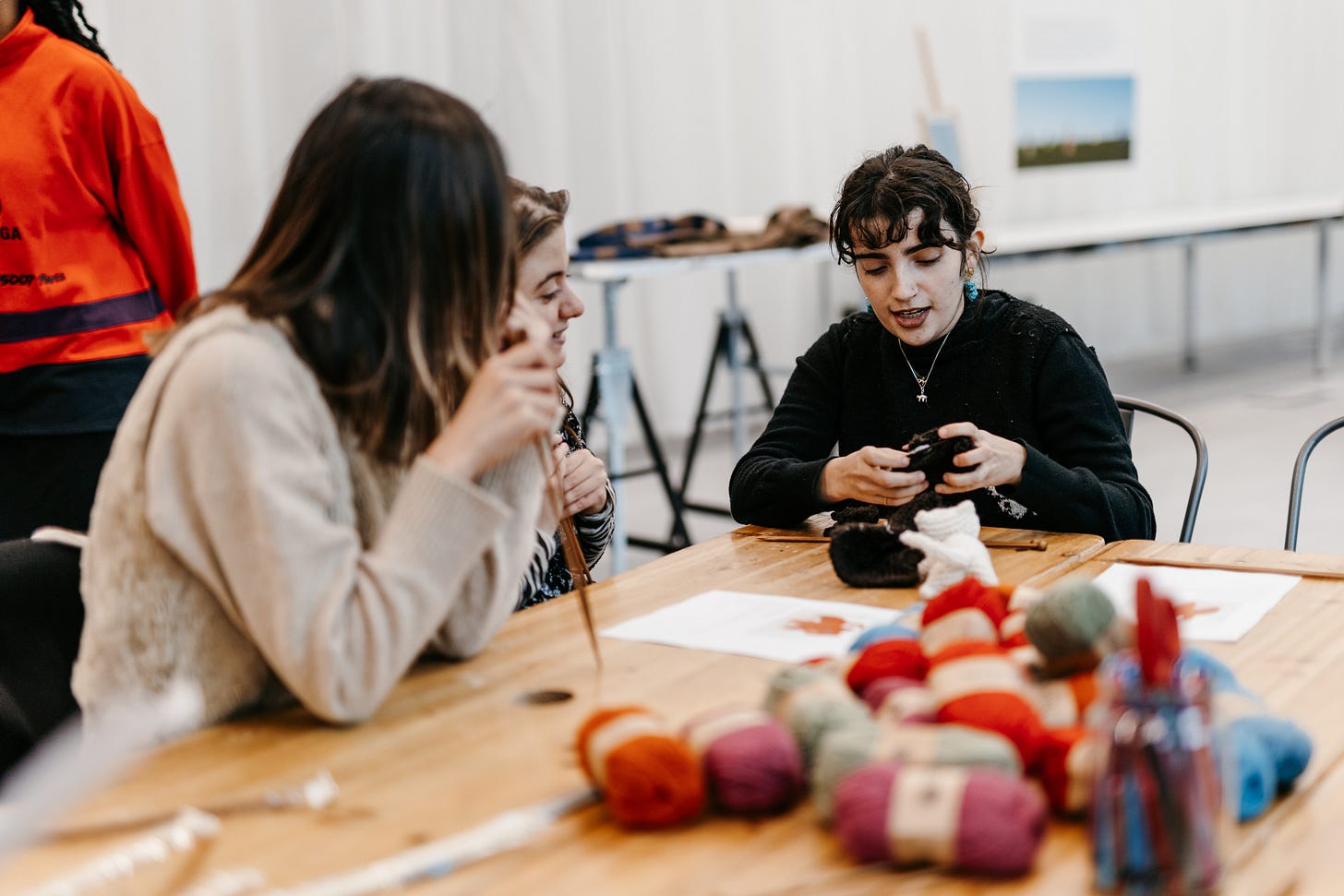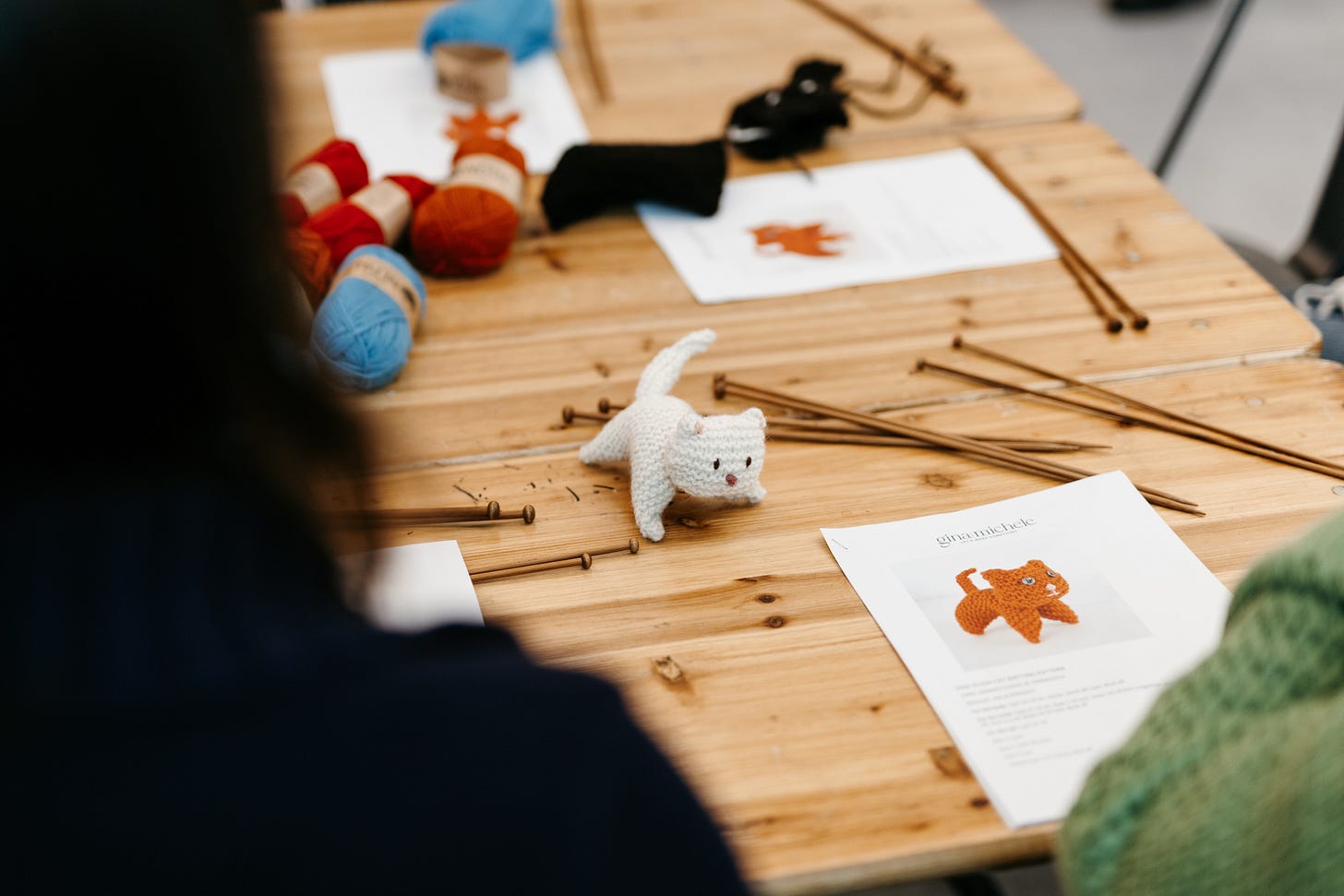In conversation with Kali Kulukundis
We spoke to Kali Kulukundis about what inspires her knitting, sourcing wool from nearby farms and material techniques.
Kali Kulukundis took over our December YKWU knitting session, and taught us how to knit adorable palm sized kittens using squares and rectangles. In the new year, we reached out to Kali as we wanted to find out more about what inspires her love for making miniature creatures and how she spins her own wool using unwanted sheep skins from local farms. In this interview, we find out more about Kali’s material sourcing methods; the reception she received from her exhibition Material Ecology: Flora, Fauna and Fibreas well as her approach to working with materials and producing small.
We will also share the audio recording soon.
How did you get into knitting?
My earliest memories of knitting come from school. I went to a school where we were taught handwork, which was basically textile skills and because of that, a lot of the girls in my school would go through phases of knitting during our free time. I also remember knitting with my grandmother, my great aunt and my mother. I was always around people knitting.
When you facilitated YKWU in December, you mentioned working with UK farms. What is your experience of working with British materials?
I’ve done a bit of stuff with the Dorset sheep, which is obviously from the UK. That’s the main British material I’ve used, because otherwise I worked in Ireland. But I’m interested in working with some of the other wools in the UK. I also foraged for wool, where if you’re in a sheep field, you get bits of wool that come off the sheep.
You mentioned foraging. How did you get into that?
Farmers are always friendly, so I approach them and also a lot of the walking paths have sheep roaming on them. Where I live, there’s a little hill and sheep roam on there but it’s also a public pathway. It’s very easy to find wool.
And do you find that more affordable? There’s always this stigma that it’s very expensive to get wool from the UK so from the approach you’re taking, do you find that the price works for you compared to other alternatives?
If you’re willing to go through the steps of processing wool yourself then wool can be relatively cheap. Most farmers are burning wool or throwing it away. I can walk into a farm where I live now and probably come back with full bags of wool. I actually met a farmer when I was writing my dissertation about the structure and history of wool in Britain and Ireland. I met a farmer near me who has a small working mill and he’ll do small batches of wool. I’m also working on a scale where I’m not trying to make loads and loads and loads of stuff. I can justify going in and getting a bag of disgusting, smelly wool that I can then process and do something with. It shouldn’t cost that much to get British wool. It’s just a branding thing. British wool is dirt cheap. It’s the Merino that is the expensive stuff, but I’m sure you already know that. It's like, nobody wants British wool, because it's too rough to wear. Most of it is bred for lamb and lamb in Britain is the reason that people breed sheep, unless you have very specialist farms, which obviously price themselves incredibly highly.
Do you go through the process of spinning wool yourself and actually creating a yarn?
Yeah, I’ve done that but there are also a few places like this place in Dorset who’ll spin small quantities of wool for you. Again, obviously that’s a price thing. There are really lovely old women who love spinning and if you’re working on a small scale, you can just approach them.

Tell us about your recent exhibition Material Ecology: Flora, Fauna and Fibre. How did it go?
It went really well. That was part of my degree graduate show and it was about folklore, so I was looking at very traditional bits of strange folk custom and using the wool from the breeds of sheep from the places I was looking at, to create these folky narratives. I naturally dyed all of my wool and I hand spun some stuff. My tutors would call me a purist because I wouldn’t use anything other than the materials I found on site.
What inspired the exhibition itself in terms of how it came about and the idea behind it?
I’ve always been interested in folklore and localising stuff. What sparked the exhibition was me foraging for this wool and the slow fashion movement. I also read a book by EF Schumacher called ‘Smallest Beautiful’, which inspired a lot of the exhibition and it’s all about small economics and small scaling stuff. And then hand knitting came from all of that stuff and then I wanted to use local wools and I wanted to tell local stories. I also like creating creatures and creating narratives through sculpture. Wool was really the main inspiration.
Do you use any other materials? I know we’ve spoken a lot about wool and sheep farming but are there any other materials that you have found creeping into your practice over the years?
I use clay as well. I’ve been doing a bit of wild clay collecting.
As in clay used for pottery or claymation?
Yes! It’s the clay you use to make pots and stuff. Although, I haven’t been making pots. I don’t use a wheel or anything, but I just sculpt with clay and I love it. Again, it’s the accessibility of the material. I don’t think with art, you necessarily have to spend money on materials. I like the idea that you can go into your, wherever it is, drive down to the beach and find some clay. I also love natural inks and charcoal. Again, I just make use of what I can find locally, or in my garden.
You’ve mentioned creatures a few times. It’d be interesting to know where your fascination with that comes from?
I’ve always been surrounded by animals and my two loves in the world, for my whole life have always been making things and animals. I'm very interested in ecology and that's something that I would love to do some more stuff about and all of my work centres around ecology. I also love the way that when you’re making things, you can create a story. The idea that you can make this funny little creature and the character you can create into something.
I also love the tangibility of small things so holding things in your hand and making things to be held, there's so much sentiment in that in a world that's so disconnected from craft. Craft is all about engaging with things in your hands.
How did you find the knitting club: first as a student and afterwards as a facilitator?
Yeah, I really enjoyed it both times. When I came in as a student, it was nice meeting a bunch of people who were also sitting around knitting. I think it’s a really nice space that you guys have created. When I came back again as a facilitator, the thing that I particularly noticed was that although you have one facilitator, you’re all just teaching each other how to knit. That was something I thought was really nice. People were all very much engaged in conversation with each other and that stemmed from saying “can you help me?” or sit next to someone more skilled. I think that was a really nice thing to see. I also met some really interesting people there. Everyone was really sweet!
What are your long term ambitions?
I’m not thinking too long term right now, but I’ve got a residency coming up in Ireland in April. So, I’ll be doing more wool stuff there. I’ve also been speaking to a school in Dorset about potentially teaching some knitting and natural dyeing classes with the students. I also might be doing some work with a costume designer as well.
Congratulations
Thank you.
About Kali
Kali graduated from the National College of Art and Design and she uses heritage wools to produce hand knitted pieces. Her work looks at the history and culture of ovine pastoralism and the slow craft movement. Her debut solo exhibition entitled Material Ecology: Flora, Fauna and Fibre looked at how local species have inspired cultural practices and traditions throughout Britain and Ireland.
Connect with Kali
» Kali’s Website «
» Kali’s Instagram «






